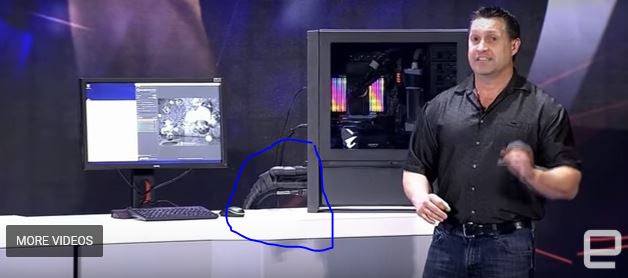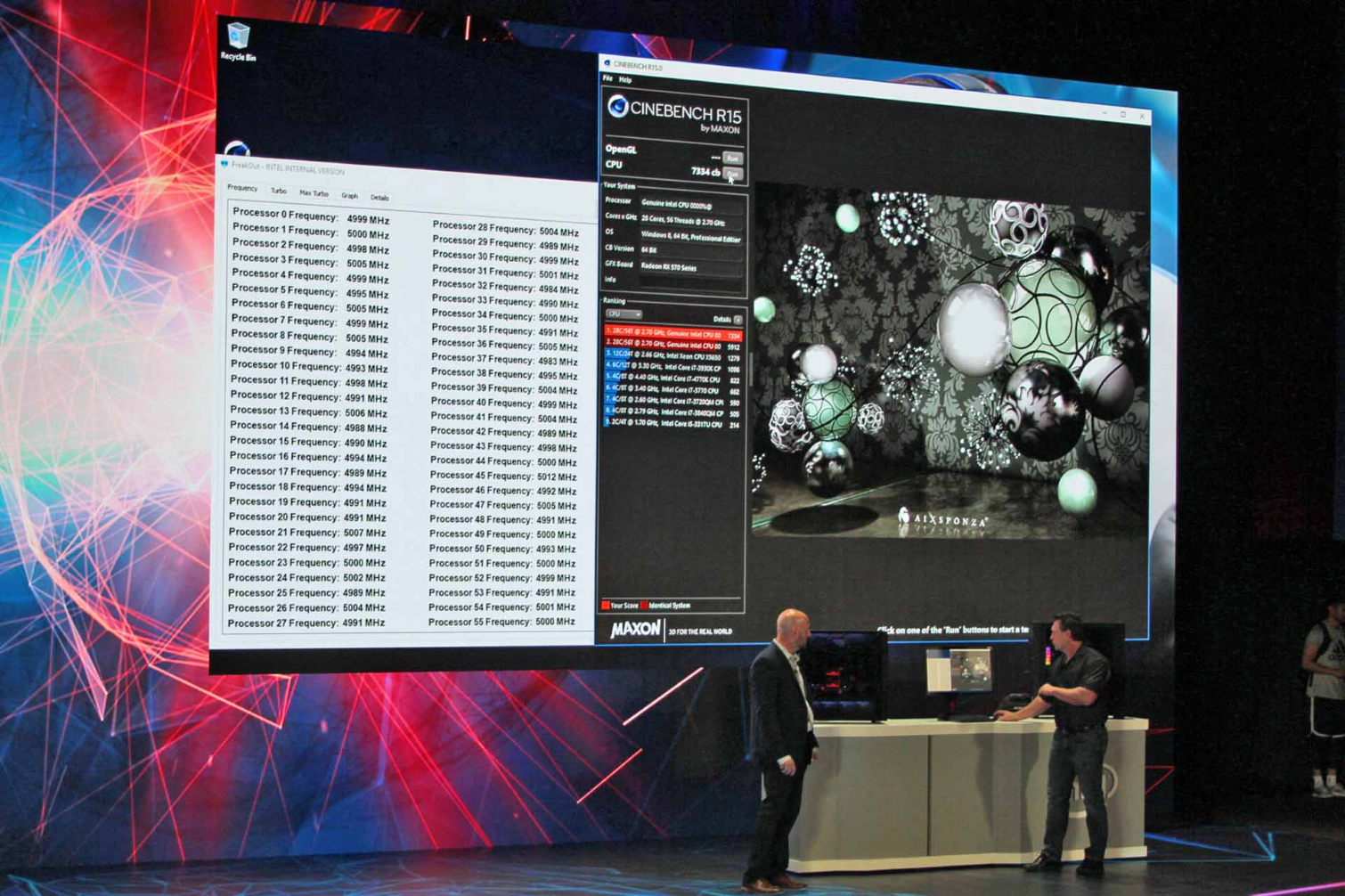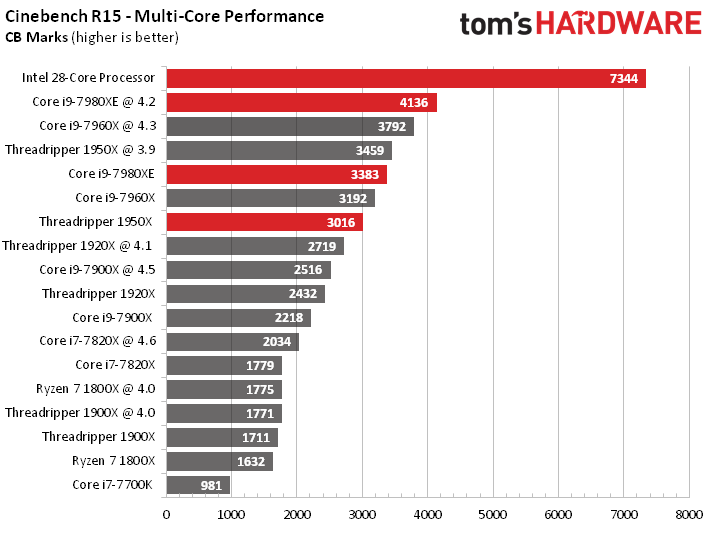At Computex, Intel Demos A 28-Core Processor Clocked At 5GHz (Updated)
EDIT: According to this image we sourced from Engadget's compressed keynote video on YouTube, Intel was apparently running some sort of closed-loop cooling that required insulating material around the tubing. This could be connected to a multi-stage phase cooler (sub-zero cooling), or possibly a more mundane water chiller, under the table. We also spot more shielding over the long rectangular waterblock and what appears to be six sticks of RAM flanking the processor on each side. That implies the platform is based on the (until now) enterprise-class LGA3647 socket. This means the processor could be a variant of the $8,700 Xeon Platinum Scalable processor we reviewed here, albeit with an unlocked multiplier. (That doesn't bode well for pricing). We'll dig for more details and update as necessary.
EDIT #2: We tracked down Intels's test system, which confirms the company was using a chiller with the test setup. Head to our Intel's 28-Core 5GHz Processor And Test System Breaks Cover article for more details.
Intel's keynote address at Computex 2018 came with a few surprises, but none were more surprising to the crowd than the demonstration of a 28-core workstation-class processor running at 5GHz. Intel says the new chip will come to market in Q4 of 2018. Before the event, Intel pre-briefed us about the 28-core model, but the company didn't disclose that it would come bearing a beastly all-core 5GHz frequency. The impressive display of multi-threaded performance probably consumed a hideous amount of power, which wouldn't lend itself well to a reasonable TDP rating for the processor. As such, we assume the processor was overclocked for the presentation.
Intel's 14nm++ process has already proven that it can sustain 5GHz easily, even with all cores active, on six-core models. Even novice overclockers can achieve a 5.0 GHz overclock on many standard off-the-shelf K-series Coffee Lake processors. But processors with higher core counts, such as the 28-core model Intel had on display, often can't reach such high frequencies on all cores, although dedicated tuning can certainly squeeze out impressive single-core frequencies.
For instance, we tested the 16-core Core i9-7960X and could only reach up to 4.3GHz before the processor was overwhelmed by the intense thermal output and 400W of power consumption. In fact, we've pushed past 350W of power consumption during some of our overclocked tests with the smaller 10-core Core i9-7900X. We've heard reports of up to 800W with the 18-core model and LN2 cooling, so its hard to speculate how much power Intel's new 28 core processor was pulling during the demonstration. It's likely that the new model has indium solder to help dissipate heat from the die, but Intel hasn't shared specifics.
Intel's 28-core processor scored 7,334 CB Marks in an all-core CineBench test. For perspective, our eighteen-core Core i9-7960X at 4.2GHz reaches up to 4,136 CB Marks. We included a mock-up chart above with Intel's results superimposed over results from our labs, but be aware that we haven't confirmed Intel's numbers and the systems were tested under different conditions. In either case, the results are incredibly impressive compared to AMD's overclocked Threadripper processors and the 16- and 18-core Intel models.
Unlike AMD, which pushes the voltage/frequency curve to the limits with its 2000-series Ryzen processors, Intel typically leaves itself plenty of room for higher frequencies. We often see this even on Intel's fastest models, which only boost up to 4.7GHz on a single core and 4.3GHz on all cores, but often overclock up to 5.1GHz on all cores.
Get Tom's Hardware's best news and in-depth reviews, straight to your inbox.
Intel's sudden push to wring the utmost performance out of its processors is obviously designed to one-up AMD before its rumored 32-core Threadripper 2 launch tomorrow. Intel also unveiled its new 40th-anniversary Core i7-8086K processor that comes with a 5GHz boost clock, and given the company's 28-core demo, we could see the company push the limits with its future mainstream desktop processors, as well.
Intel also announced that it would have new S-Series models coming this year. These are obviously the Whiskey Lake processors, but Intel left us hanging on the details. It would be nice if Intel threw a curveball and deployed a completely new microarchitecture for the first time in four years, but that doesn't seem to be likely. For now, it appears that Intel is leaving its new microarchitectures locked behind the next step on the process ladder. It's puzzling that Intel hasn't simply brought a new microarchitecture to the existing process, thereby offering larger performance benefits than we see with the rewarmed Skylake architecture.
In either case, Intel has a proven process and microarchitecture that still has some gas in the tank. If Intel carries this new approach over to its S-Series processors, it will set the stage for a much more interesting battle with AMD as Intel rolls out new mainstream desktop chips with higher core counts and record-setting stock frequencies.

Paul Alcorn is the Editor-in-Chief for Tom's Hardware US. He also writes news and reviews on CPUs, storage, and enterprise hardware.
-
justin.m.beauvais Did they make tea with the water they boiled cooling the thing?Reply
"Thanks for watching our demo! Complimentary tea?"
That said, it is an impressive demo. Kudos to Intel for finally ramping it up and showing us some real performance gains in their CPUs. -
Aspiring techie I bet this thing will cost an arm, a leg, and a kidney.Reply
But seriously, that is sweet. Finally, Intel is getting off their lazy tails and giving some meaningful improvements, at least in HEDT. -
derekullo If we extrapolate the TDP from the performance on Cinebench with the Core i9-7960X having a TDP of 400 watts ...Reply
7344 / 4136 = 1.77 x 400 watts = 710 estimated TDP.
This is in the range of portable space heaters ...
800 Watt Soleil Infrared Dish Electric Space Heater
https://www.walmart.com/ip/Soleil-Infrared-Dish-Electric-Space-Heater-Black-DF1015/119424847 -
ammaross You know for a fact this 28 core CPU isn't 5.0Ghz all-core. Their 18-core can't even do that. Their server-grade 28-core CPUs don't even get near that. This CPU is 2.7Ghz base-clock, so maybe will be 4.4+Ghz single-core turbo at stock. They likely OCed it under LN2 to give a "best case" shocker score. Still impressed none-the-less, but I'll wait patiently to see where real life scenarios rank this costly beast (just look at 28-core Xeons to see where the price will fall ).Reply -
InvalidError Reply
Intel has had another year to tune 14nm and the architecture. Part of Skylake-(E)X somewhat low clock frequencies is also likely due to Intel rushing the launches to counter Ryzen, ThreadRipper and EPYC, so the chips may have not performed quite up to par with Intel's original plans.21029908 said:You know for a fact this 28 core CPU isn't 5.0Ghz all-core. Their 18-core can't even do that.
I agree this is unlikely to be stock. However, I wouldn't be surprised if stock clocks turned up much higher than Skylake-(E)X. -
Paul Alcorn Reply
Check out the image and the updated text I just added. Most definitely NOT at stock. tsk tsk.21030030 said:
Intel has had another year to tune 14nm and the architecture. Part of Skylake-(E)X somewhat low clock frequencies is also likely due to Intel rushing the launches to counter Ryzen, ThreadRipper and EPYC, so the chips may have not performed quite up to par with Intel's original plans.21029908 said:You know for a fact this 28 core CPU isn't 5.0Ghz all-core. Their 18-core can't even do that.
I agree this is unlikely to be stock. However, I wouldn't be surprised if stock clocks turned up much higher than Skylake-(E)X.


